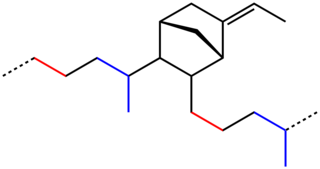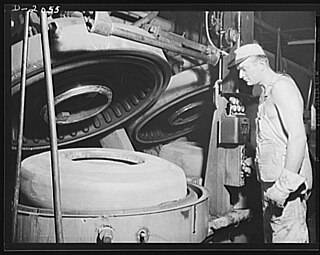Related Research Articles

Waldo Lonsbury Semon was an American inventor born in Demopolis, Alabama. He is credited with inventing methods for making polyvinyl chloride useful.

EPDM rubber is a type of synthetic rubber that is used in many applications.
In organic chemistry, ozonolysis is an organic reaction where the unsaturated bonds are cleaved with ozone. Multiple carbon–carbon bond are replaced by carbonyl groups, such as aldehydes, ketones, and carboxylic acids. The reaction is predominantly applied to alkenes, but alkynes and azo compounds are also susceptible to cleavage. The outcome of the reaction depends on the type of multiple bond being oxidized and the work-up conditions.
A synthetic rubber is an artificial elastomer. They are polymers synthesized from petroleum byproducts. About 32 million metric tons of rubbers are produced annually in the United States, and of that amount two thirds are synthetic. Synthetic rubber, just like natural rubber, has many uses in the automotive industry for tires, door and window profiles, seals such as O-rings and gaskets, hoses, belts, matting, and flooring. They offer a different range of physical and chemical properties which can improve the reliability of a given product or application. Synthetic rubbers are superior to natural rubbers in two major respects: thermal stability, and resistance to oils and related compounds. They are more resistant to oxidizing agents, such as oxygen and ozone which can reduce the life of products like tires.

In organic chemistry, olefin metathesis is an organic reaction that entails the redistribution of fragments of alkenes (olefins) by the scission and regeneration of carbon-carbon double bonds. Because of the relative simplicity of olefin metathesis, it often creates fewer undesired by-products and hazardous wastes than alternative organic reactions. For their elucidation of the reaction mechanism and their discovery of a variety of highly active catalysts, Yves Chauvin, Robert H. Grubbs, and Richard R. Schrock were collectively awarded the 2005 Nobel Prize in Chemistry.

Polybutadiene [butadiene rubber, BR] is a synthetic rubber. It offers high elasticity, high resistance to wear, good strength even without fillers, and excellent abrasion resistance when filled and vulcanized. "Polybutadiene" is a collective name for homopolymers formed from the polymerization of the monomer 1,3-butadiene. The IUPAC refers to polybutadiene as "poly(buta-1,3-diene)". Historically, an early generation of synthetic polybutadiene rubber produced in Germany by Bayer using sodium as a catalyst was known as "Buna rubber". Polybutadiene is typically crosslinked with sulphur, however, it has also been shown that it can be UV cured when bis-benzophenone additives are incorporated into the formulation.

Robert Howard GrubbsForMemRS was an American chemist and the Victor and Elizabeth Atkins Professor of Chemistry at the California Institute of Technology in Pasadena, California. He was a co-recipient of the 2005 Nobel Prize in Chemistry for his work on olefin metathesis.

Cracks can be formed in many different elastomers by ozone attack, and the characteristic form of attack of vulnerable rubbers is known as ozone cracking. The problem was formerly very common, especially in tires, but is now rarely seen in those products owing to preventive measures.

An antiozonant, also known as anti-ozonant, is an organic compound that prevents or retards damage caused by ozone. The most important antiozonants are those which prevent degradation of elastomers like rubber. A number of research projects study the application of another type of antiozonants to protect plants as well as salmonids that are affected by the chemicals.

The Charles Goodyear Medal is the highest honor conferred by the American Chemical Society, Rubber Division. Established in 1941, the award is named after Charles Goodyear, the discoverer of vulcanization, and consists of a gold medal, a framed certificate and prize money. The medal honors individuals for "outstanding invention, innovation, or development which has resulted in a significant change or contribution to the nature of the rubber industry". Awardees give a lecture at an ACS Rubber Division meeting, and publish a review of their work in the society's scientific journal Rubber Chemistry and Technology.
The Melvin Mooney Distinguished Technology Award is a professional award conferred by the ACS Rubber Division. Established in 1983, the award is named after Melvin Mooney, developer of the Mooney viscometer and of the Mooney-Rivlin hyperelastic law. The award consists of an engraved plaque and prize money. The medal honors individuals "who have exhibited exceptional technical competency by making significant and repeated contributions to rubber science and technology".
Harry Linn Fisher was the 69th national president of the American Chemical Society, and an authority on the chemistry of vulcanization. Fisher was the author of four popular books on the chemistry and technology of rubber, and the holder of 50 patents.
Samuel Emmett Horne Jr. was a research scientist at B. F. Goodrich noted for first synthesizing cis-1,4-polyisoprene, the main polymer contained in natural tree rubber, using Ziegler catalysis. Earlier attempts to produce synthetic rubber from isoprene had been unsuccessful, but in 1955, Horne prepared 98 percent cis-1,4-polyisoprene via the stereospecific polymerization of isoprene. The product of this reaction differs from natural rubber only slightly. It contains a small amount of cis-1,2-polyisoprene, but it is indistinguishable from natural rubber in its physical properties.
Herbert A. Winklemann was a chemist at B. F. Goodrich, known as a co-inventor of the first antioxidant, AgeRite, developed in 1924 and marketed for rubber. He wrote an early account of rubber recycling, and he studied the mitigation of ozone cracking. He held 48 patents in the field of rubber technology, retiring as Technical Director at Dryden Rubber Co.
Francis Paul Baldwin was a former Exxon Chief Scientist noted for his work on chemical modifications of low functionality elastomers.

Sulfur vulcanization is a chemical process for converting natural rubber or related polymers into materials of varying hardness, elasticity, and mechanical durability by heating them with sulfur or sulfur-containing compounds. Sulfur forms cross-linking bridges between sections of polymer chains which affects the mechanical and electronic properties. Many products are made with vulcanized rubber, including tires, shoe soles, hoses, and conveyor belts. The term vulcanization is derived from Vulcan, the Roman god of fire.
Judit Puskas is a Distinguished Ohio State University professor noted as co-inventor of the polymer used on the Taxus-brand coronary stent. She is the first woman to win the Charles Goodyear Medal, the highest honor conferred by the American Chemical Society's Rubber Division. Her research focuses on polymer engineering for breast reconstruction in cancer treatment, green polymer chemistry, biomimetic processes, biomaterials, living polymerization, polymerization mechanisms and kinetics, thermoplastic elastomers, polymer structure/property relationships, and polymer-bio interfaces.
Sudhin Datta is an ExxonMobil Chemical scientist noted for the development of Vistamaxx propylene-based elastomers.
Robert P. Lattimer is a retired chemist who worked for Lubrizol as an Advanced Materials research and development technical fellow. He is an advocate for including intelligent design in public science curriculum.
Joginder Lal was a Goodyear Polymer Research Manager and expert in the synthesis and mechanism of the formation of high polymers.
References
- ↑ "Background report for Robert Layer". radaris.com. Retrieved 29 December 2024.
- ↑ Layer, Robert W. (1 October 1963). "The Chemistry of Imines". Chem. Rev. 63 (5): 489–510. doi:10.1021/cr60225a003 . Retrieved 17 August 2022.
- ↑ "1312 Diplomas to be awarded at UC Commencement". Cincinnati Times Star. Cincinnati Times Star. 2 June 1955. Retrieved 26 December 2024.
- ↑ "Robert Layer Obituary". Legacy.com. Legacy.com. 21 December 2022. Retrieved 26 December 2024.
- ↑ "People - Industry". Chemical & Engineering News. 58 (3): 62. 21 January 1980. doi: 10.1021/cen-v058n003.p061 . Retrieved 29 September 2022.
- ↑ "People". Chemical & Engineering News. 33 (34): 3505. August 1955. doi: 10.1021/cen-v033n034.p3500 . Retrieved 29 September 2022.
- ↑ Layer, Robert W. "US4324717A Norbornene polymers stabilized with hindered aromatic alcohols". patents.google.com. U.S. Patent Office. Retrieved 26 December 2024.
- ↑ Layer, Robert W.; Tenney, Linwood P. "Norbornene polymers containing bound phenolic antioxidant". patents.google.com. U.S. Patent Office. Retrieved 26 December 2024.
- ↑ Layer, R. W.; Lattimer, R. P. (1990). "Protection of rubber against ozone". Rubber Chemistry and Technology. 63 (3): 426–45. doi:10.5254/1.3538264.